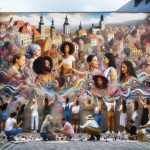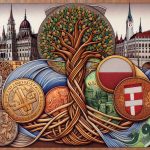
Taking pictures in Poland is an exciting way to see what the country is all about. You get to experience its cities, landscapes, and people up close. In Warsaw, you’ll find a city that’s always moving and changing, full of modern life.
Kraków, on the other hand, pulls you into its history with every corner you turn. Gdańsk mixes old and new in a way that’s truly special, while the Tatra Mountains offer stunning views of nature. Each photo tells its own story, giving us a glimpse into Poland’s diverse character.
This journey is not just about seeing different places, but also about connecting with Poland’s culture and traditions. It’s an invitation to dive deeper into what makes this country so captivating.
Capturing Warsaw’s Urban Pulse
In Warsaw, the capital of Poland, the streets are alive with stories waiting to be told through photography. The city’s unique mix of buildings – from old historical sites and buildings reflecting socialist realism, to towering modern skyscrapers – provides a fascinating setting for photographers. They use their cameras to show how Warsaw has overcome challenges and is continuously evolving. Photographers are drawn to the contrasts in the city, capturing moments that show the relationship between people and their surroundings in a real and powerful way.
For example, a photographer might focus on the rush of people heading to work in the morning, contrasting it with the relaxed atmosphere of those sitting in a café. These images go beyond the surface, showing the city’s rhythm and how its inhabitants interact with it. Warsaw acts as a living stage where the past and the future are constantly interacting.
The city’s architecture plays a significant role in these photographic stories. Consider the Royal Castle, which stands as a symbol of Warsaw’s historical resilience, having been reconstructed after being destroyed in World War II. Nearby, the modern design of the Złote Tarasy shopping center reflects Warsaw’s economic growth and modernization. Photographers capture these elements, showing how they coexist and shape the city’s identity.
In doing so, photographers not only document the city’s physical landscape but also its emotional landscape. Through their work, they invite viewers to see Warsaw not just as a place of bricks and mortar, but as a living, breathing entity with a story to tell. Their photos can challenge perceptions, highlight unseen aspects of city life, and celebrate its diversity and vibrancy.
This approach to photography in Warsaw encourages us to look closer at our own environments, to see the stories unfolding around us every day. It reminds us that every city has its unique rhythm and narrative, waiting to be captured and shared.
The Soul of Kraków
Kraków, a city rich in history, beckons photographers to explore its depths and capture its unique essence. As you walk through its cobblestone streets, you’ll notice how the city’s ancient architecture and vibrant life blend together. Take Wawel Castle, for instance, towering above the Vistula River, offering stunning views and a glimpse into Poland’s royal past.
Then there’s the bustling Market Square, where the daily lives of locals intertwine with centuries of history, making it a perfect spot for candid photography. St. Mary’s Basilica stands out with its Gothic design and the iconic trumpet call that marks each hour, providing a captivating audio-visual experience. Meanwhile, the Jewish Quarter, Kazimierz, presents a quieter but equally compelling scene. Its history, marked by both cultural flourish and tragic events, adds a profound layer to your photographs, inviting reflection on the city’s complex past.
Photographers will find Kraków pulsating with life, from the lively cafes and street musicians that fill the air with energy to the solemn historic sites that command respect. Each photo captures a piece of Kraków’s spirit, whether it’s the joyous laughter in a café or the silent reverence at a historic monument.
For those looking to document Kraków’s essence, a good recommendation would be to use a camera that excels in both low-light and vivid daylight settings, such as the DSLR cameras from the Canon EOS series or mirrorless options from Sony’s Alpha range. These cameras can help capture the intricate details of Kraków’s architecture and the dynamic range of its urban and natural landscapes.
In a conversational tone, it’s clear that Kraków isn’t just a city; it’s a living museum where every corner has a story to tell. Through photography, we can both preserve and share these stories, connecting with the city’s soul on a personal level. Whether you’re a seasoned photographer or someone looking to capture memories, Kraków welcomes you to discover its beauty and history, one photo at a time.
Gdańsk: Where History Meets Modernity
Gdańsk is a city that brilliantly showcases the blend of Poland’s rich history and its modern progress. For photographers, this city presents an exceptional opportunity to capture the essence of this unique combination. The heart of Gdańsk is its Old Town, which has been carefully restored to show off its historical architecture. Here, visitors can see a range of styles, from medieval churches to the elaborate designs of the Renaissance. These buildings aren’t just beautiful; they tell the stories of the city’s past.
Moving through Gdańsk, the transition from its historical aspects to its modern-day life is striking. The streets are lively, filled with people and the energy of contemporary art that dots the city. A prime example of this blend is the Crane over the Motława River. Originally a medieval port crane, it now stands as a symbol of Gdańsk’s maritime history, surrounded by modern cafes that add a fresh vibe to the area.
Photographers will find that Gdańsk offers a dynamic scene to explore. The interplay of light across the different textures of the city—from the ancient bricks of the Old Town to the sleek surfaces of modern design—creates endless opportunities for captivating images.
Moreover, Gdańsk is not just about looking back; it’s a city that looks forward too. Its commitment to preserving its history while embracing the new makes it a fascinating study in how cities can evolve without losing their soul. For those interested in capturing the essence of a place where history and modernity coexist, Gdańsk is a city that should not be missed.
The Natural Wonders of the Tatra Mountains
Leaving Gdańsk’s cityscape behind, the Tatra Mountains emerge as a natural wonder, presenting a completely different scene for photography enthusiasts. Unlike the urban environment, here, the high peaks reach towards the sky, and calm lakes reflect the changing sky above. The thick forests, filled with various shades of green, brown, and autumn gold, are home to diverse wildlife and provide stunning views. The changing light creates unique scenes, making every moment perfect for photography. Photographers often seek the golden hour, the time when sunlight makes everything look its best.
In the Tatra Mountains, every shot captures the magnificent interplay between nature’s grand scenes and its fragile balance. This means not just taking photos, but also understanding how nature works together, creating scenes worth capturing. For those interested in photography, it’s not just about the right equipment. While a good camera and lenses are important, knowing the best times for photography, such as dawn or dusk, can make a big difference in the quality of the photos.
This place is not just for professional photographers but also for anyone who appreciates nature. It offers a chance to see the beauty of the natural world up close, from the wildlife living in the forests to the stunning mountain views. The Tatra Mountains serve as a reminder of the world’s natural beauty, encouraging us to explore and appreciate our surroundings. Whether you’re there to capture the perfect shot or simply to enjoy the view, the Tatras provide an unforgettable experience.
Festivals and Traditions: A Cultural Journey
Poland is a country where festivals and traditions paint a vivid picture of its culture, blending history with modern life to celebrate community and heritage. The Kraków Festival, for instance, stands out with its lively dances and bright costumes. It’s more than just an event; it’s a showcase of Poland’s cultural richness. Similarly, All Saints’ Day in Poland offers a moment of reflection, remembering loved ones in a solemn yet beautiful tradition. These festivals capture the essence of Polish culture through photographs, bringing to life the joy, the sorrow, and the camaraderie shared amongst participants.
Traditional Polish music plays a crucial role in these celebrations, with its rhythmic beats guiding dancers in movements handed down over generations. This music isn’t just background noise; it’s a living piece of Poland’s cultural heritage, inviting everyone to join in the dance. Each photo of these moments does more than just document; it highlights the enduring nature of Polish culture, encouraging people to explore the depths of Poland’s traditions.
To truly understand the impact of these festivals, one might consider attending the Kraków Festival. Here, the vibrant dances and traditional music offer a firsthand experience of Poland’s cultural wealth. For those unable to visit, numerous online platforms and documentaries provide a glimpse into these celebrations, making it possible to virtually participate in Poland’s rich traditions. These resources serve not only as entertainment but also as educational tools, offering insights into the significance of preserving cultural heritage.
In discussing Poland’s festivals and traditions, it’s clear that they are not relics of the past but vibrant expressions of a living culture. They bridge the gap between generations, teaching new audiences the importance of community and shared history. Through a straightforward exploration of these cultural events, it’s evident that Poland’s heritage is a dynamic force, continually evolving while staying rooted in tradition.
Conclusion
Taking pictures in Poland is like going on an amazing adventure. You get to see so many different things.
In Warsaw, the city is alive and buzzing with energy. Then there’s Gdańsk, which is full of history. Kraków is all about culture and has a really unique vibe. And if you love nature, the Tatra Mountains are absolutely stunning.
Each place lets you capture something special – not just what they look like, but the stories and traditions of the people there. It’s like you get to freeze a piece of Poland’s soul in a photo, showing off its variety, strength, and beauty to everyone.






Comments are closed.